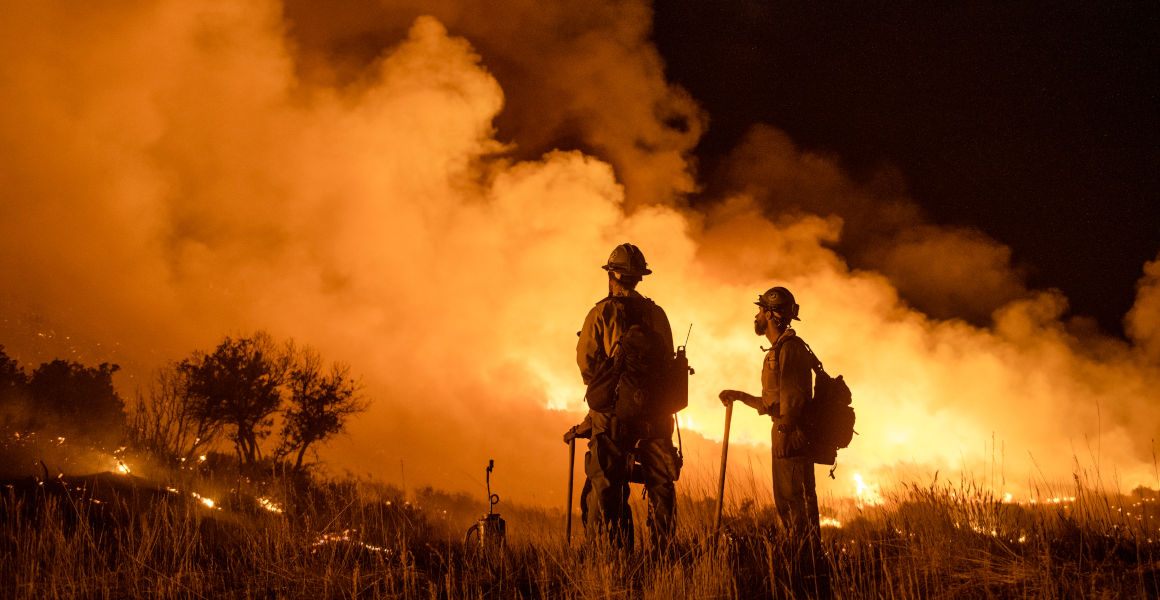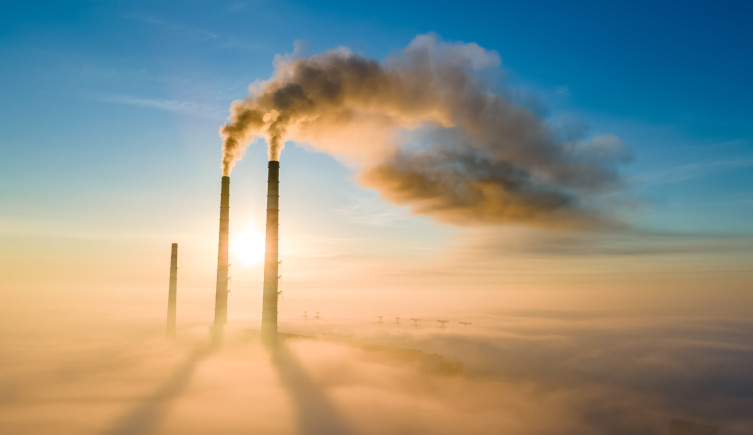Our planet’s health is getting worse - and we must act now to turn it around.
A new report finds that as Earth reaches dangerous extremes, opportunities to reduce the damage are becoming harder to find.

Rising temperatures are contributing to more intense wildfires worldwide. Public domain image by Kyle Miller, Wyoming Hotshots, USFS from Flickr.
Our planet’s health is getting worse - and we must act now to turn it around.
A new report finds that as Earth reaches dangerous extremes, opportunities to reduce the damage are becoming harder to find.
Earth’s climate is entering “uncharted territory” – and we have no idea what’s coming next.
This was the message from the 2023 State of the Climate report, which measures how the planet is faring based on 35 vital signs. As levels of heat and carbon dioxide hit record heights, the authors are blunt about the challenges facing humanity.
‘As scientists, we are increasingly being asked to tell the public the truth about the crises we face in simple and direct terms,’ they wrote. ‘The truth is that we are shocked by the ferocity of the extreme weather events in 2023. We are afraid of the uncharted territory that we have now entered.’
While the report doesn’t make for cheerful reading, a few vital signs are moving in the right direction. Levels of renewable energy are at an all-time high and continuing to rise, while the loss of the world’s forests is in decline.
The report also emphasises that restoring the rest of Earth’s vitals is in our hands. By demanding our governments, businesses and institutions act now to stem its decline, we have the best remaining chance of preserving our planet.
The full report was published in the journal BioScience.

Sea ice is hitting record low levels, while glaciers are in retreat. Image © MomentumStock/Shutterstock.
The past year has been a time of climate firsts, mainly for the wrong reasons. There have been over 38 days this year that were more than 1.5⁰C hotter than average – higher than any other year on record.
This follows a warning from the World Meteorological Organisation that 1.5⁰C of warming will start to become the norm in the next five years – and become permanent by the mid-2030s.
Meanwhile, the oceans have also been rapidly heating up. While the oceans’ ability to absorb heat has helped to buffer our climate, there are concerns that they may be reaching their capacity.
This year, sea surface temperatures hit record highs for four months, and were almost 1⁰C hotter than is normal at this time of year.
This had a devastating effect on Antarctic sea ice, which has shrunk drastically over the past decade. It collapsed to a historic low this year, being around a million square kilometres smaller than the previous record from 1986 – an area of ice around four times the size of the UK.
Wildfires, extreme heat and storms have also been constant across the year, with concerns that Earth’s climate may already be passing tipping points that will be hard to recover from anytime soon.
Dr Christopher Wolf, a co-author of the report, says, ‘As scientists, we are hugely troubled by the sudden increases in the frequency and severity of climate-related disasters.’
‘The frequency and severity of those disasters might be outpacing rising temperatures. By the end of the 21st century, as many as three to six billion people may find themselves outside the Earth’s liveable regions, meaning they will be encountering severe heat, limited food availability and elevated mortality rates.’
While 2023’s records may have been contributed to by other factors, including natural climate patterns like El Niño, these are just exacerbating the increases that climate change is already causing.

Levels of carbon dioxide in the atmosphere have never been higher than now during the entire existence of our species. Image © Bilanol/Shutterstock.
Since the last report, 20 out of the 35 vitals have hit all-new records. These are a mixture of both good and bad moments in the ongoing climate crisis.
Starting with the bad news, it’s estimated that concentrations of carbon dioxide now stand at around 421 parts per million. Levels as high as this haven’t been seen since the Pliocene around four million years ago, back when oceans were over 20 metres higher than they were today and mastodon roamed the Earth.
Emissions of carbon dioxide have also reached a new high, at around 39 gigatonnes per year. While they appear to be levelling off over the long term, emissions need to be declining rapidly by the end of the decade if there is to be any chance of global warming being limited to just 1.5⁰C.
These emissions are being driven by fossil fuel subsidies, which reached new heights in 2022. Driven by the impact of the war in Ukraine, the amount nations paid to keep the prices of polluting coal, oil and gas artificially low reached £900 million, more than double the figure for 2021.
On the plus side, renewable energy is now coming into its own. Enough wind and solar power was generated last year to power the UK more than four times over – and is set to rise even further in the years to come.
A recent report from the International Energy Agency (IEA) found that by 2030, renewable energy will provide as much as half the planet’s electricity. Coal, oil and gas emissions will have peaked, as carbon emissions from the energy sector start to decline.
The IEA’s Executive Director, Fatih Birol, says, ‘The transition to clean energy is happening worldwide and it’s unstoppable. It’s not a question of “if”, it’s just a matter of “how soon” – and the sooner the better for all of us.’
‘Governments, companies and investors need to get behind clean energy transitions rather than hindering them. There are immense benefits on offer, including new industrial opportunities and jobs, greater energy security, cleaner air, universal energy access and a safer climate for everyone.’
The IEA warned that, even with this progress, the use of fossil fuels is still far too high, with the planet on course to warm by as much 2.4⁰C this century – far above safe limits.

Power from renewable sources is rising, and will continue to do so as net zero goals get closer. Image © anatoliy_gleb/Shutterstock.
Looking to the future, the State of the Climate report identified six key areas that humanity needs to focus on to save our planet. Because of the linked nature of the threats, the recommendations focus not just on the climate crisis, but also on those affecting biodiversity, food security and disease.
Some of the recommendations, like stopping global warming and phasing out the use of coal, are relatively straightforward. As well as cutting emissions, the team also called for more research into how more carbon dioxide can be absorbed.
While the team prioritised expanding nature-based solutions to this problem, such as restoring forests, they also said that new technology to take greenhouse gases out of the atmosphere will be needed.
At the moment, this industry is still in its infancy, and hasn’t yet been tested at a large scale. While recommending that negative emissions technology must be explored, the paper warns that relying on its development can’t be an alternative to slashing emissions.
There are also more complex proposals in the report. It echoes the call of a group of economists, including former Bank of England Governor Mark Carney, that our economies should be transformed to support the needs of people and planet.
This transition must be done fairly to ensure social and climate justice for the world’s countries, with nations needing to share resources more equally so that everyone can benefit.
Having sounded the alarm in four previous reports, and seen little progress made so far, the researchers are aware that change will not be immediate. But as the effects of climate change become more pronounced, they hope that more people will start to take notice.
Professor William Ripple, the report’s lead author, says, ‘Life on our planet is clearly under siege. The statistical trends show deeply alarming patterns of climate-related variables and disasters, and so far, there has been little progress to report as far as humanity combating climate change.’
‘As scientists, our goal is to communicate climate facts and make policy recommendations. It is our moral duty to alert humanity of any potential existential threat and to show leadership in taking action.’

Taking small, actionable steps can have a big impact when it comes to helping the planet.

Hear from scientists, activists and people at the forefront of the climate and biodiversity crises.
Don't miss a thing
Receive email updates about our news, science, exhibitions, events, products, services and fundraising activities. We may occasionally include third-party content from our corporate partners and other museums. We will not share your personal details with these third parties. You must be over the age of 13. Privacy notice.
Follow us on social media